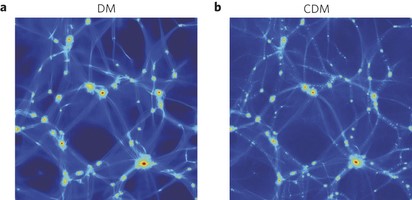In cosmology, cold dark matter is believed to be a form of matter which moves slowly in comparison with light and interacts weakly with electromagnetic radiation. It is estimated that only a minute fraction of the matter in the Universe is baryonic matter, which forms stars, planets and living organisms. The rest, comprising over 80%, is dark matter and energy.
Dark matter is considered a theory because it has to exist - it just isn't defined. The current theory is instead an intellectual method to explain how the universe evolved from its initial state to the current distribution of galaxies and clusters, the structure of the Universe on a large scale. What we knew about black holes 35 years ago is almost all completely changed or even wrong now, and the same may happen with dark matter but, in any case, the current hypothesis is unable to satisfactorily explain some observations.
Tom Broadhurst, an Ikerbasque researcher at the University of the Basque Country (UPV/EHU), explains that, "guided by the initial simulations of the formation of galaxies in this context, we have reinterpreted cold dark matter as a Bose-Einstein condensate". So, "the ultra-light bosons forming the condensate share the same quantum wave function, so disturbance patterns are formed on astronomic scales in the form of large-scale waves".

This figure shows that a comparison of the distribution of matter is very similar on a large scale between wave dark matter, the focus of this research, and the usual dark matter particle.
(b) This figure shows that in galaxies the structure is very different in the interpretation of the wave, which has been carried out in this research; the research predicts the soliton of dark matter in the centre surrounded by an extensive halo of dark matter in the form of large "spots", which are the slowly fluctuating density waves. This leads to many predictions and solves the problem of puzzling cores in smaller galaxies. Credit: Broadhurst
This hypothesis can be used to suggest that all the galaxies in this context should have at their center large stationary waves of dark matter called solitons, which would explain the puzzling cores observed in common dwarf galaxies.
The hypothesis also makes it possible to predict that galaxies are formed relatively late in this context in comparison with the interpretation of standard particles of cold dark matter. The team is comparing these new predictions with observations by the Hubble space telescope.
This opens up the possibility that dark matter could be regarded as a very cold quantum fluid that governs the formation of the structure across the whole Universe.





Comments